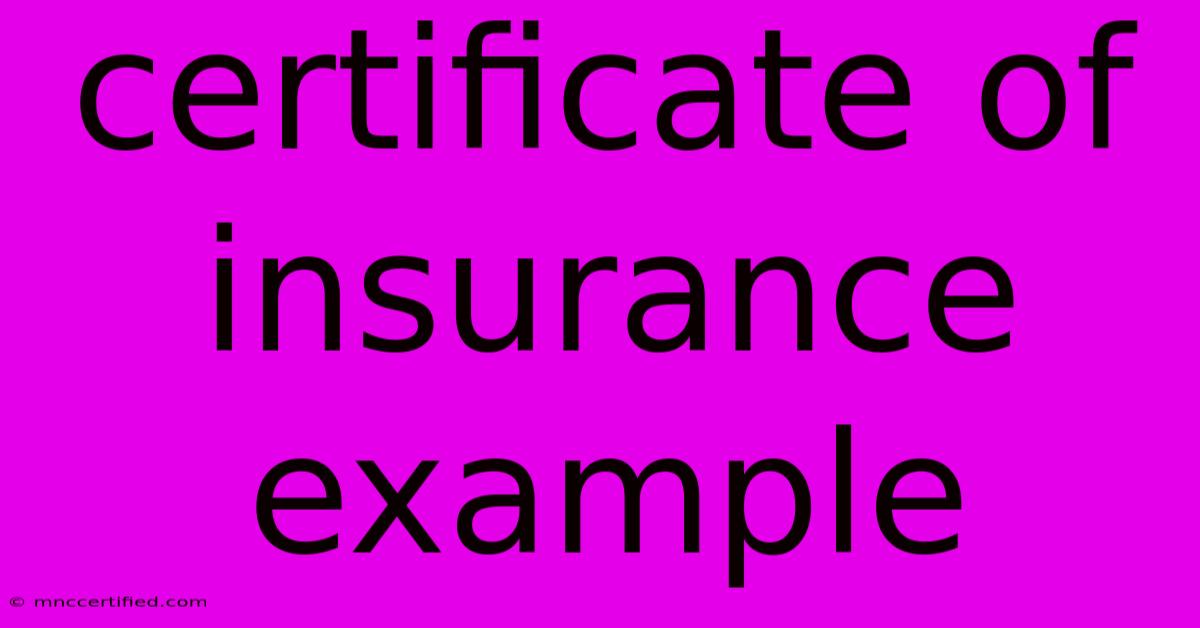Certificate Of Insurance Example

Table of Contents
Certificate of Insurance Example: A Comprehensive Guide
A Certificate of Insurance (COI) is a crucial document proving a business or individual holds valid insurance coverage. It's not the insurance policy itself, but rather a summary confirming the existence and key details of the policy. Understanding what a COI looks like and what information it contains is vital for both policyholders and those who request them. This guide provides a detailed look at a certificate of insurance example, explaining its components and significance.
What is a Certificate of Insurance (COI)?
A COI serves as proof of insurance, acting as a quick reference for those needing assurance of your liability coverage. Think of it as a snapshot of your insurance policy, highlighting essential details. It's commonly requested by landlords, contractors, clients, and event organizers to mitigate risk. The COI doesn't replace the actual policy; it simply verifies its existence.
Key Components of a Certificate of Insurance Example
While the exact format might vary slightly between insurance providers, a standard COI typically includes the following information:
- Policyholder Information: This section identifies the insured party – the business or individual covered by the insurance policy. It includes the name, address, and sometimes contact information.
- Insurer Information: This details the insurance company issuing the policy, including its name, address, and contact details. This allows recipients to verify the policy's authenticity.
- Policy Number: A unique identifier for the insurance policy. This number is crucial for accessing specific policy details.
- Policy Effective and Expiration Dates: These dates indicate the period when the insurance coverage is active. A COI is only valid during this timeframe.
- Type(s) of Insurance: This section specifies the types of insurance coverage included in the policy, such as General Liability, Workers' Compensation, Auto Liability, and Professional Liability (Errors & Omissions). The specific coverages depend on the policyholder's needs.
- Limits of Liability: This crucial section states the maximum amount the insurance company will pay for covered claims. It's usually expressed in monetary terms (e.g., $1,000,000 General Liability). This is a key element for assessing risk.
- Additional Insured: This section is crucial and often overlooked. It lists any parties explicitly named as additional insureds on the policy, extending coverage to them. This is frequently requested by clients or landlords for protection.
- Certificate Holder Information: This section provides the details of the entity requesting the COI, indicating who benefits from the proof of insurance.
- Broker Information: Contact information for the insurance broker who arranged the policy. This is helpful for any questions or clarifications.
Understanding a COI Example: A Visual Breakdown
While we can't display a visual COI here directly due to formatting limitations, imagine a document organized into sections as described above. Each section is clearly labeled, and the information within is concise and easy to understand. The key is the clarity and accuracy of the provided data.
Why is a COI Important?
A COI offers several benefits:
- Risk Mitigation: It provides assurance to the certificate holder that the policyholder has adequate insurance coverage, reducing potential financial liability.
- Contractual Requirements: Many contracts necessitate a COI as a condition of the agreement.
- Compliance: Certain industries require COIs to comply with regulations and safety standards.
- Peace of Mind: It offers reassurance to all parties involved, knowing that insurance coverage exists in case of incidents or accidents.
Common Mistakes to Avoid When Using a COI
- Outdated COIs: Always ensure the COI is current and valid. An expired COI is useless.
- Incorrect Information: Verify all information on the COI for accuracy. Mistakes can lead to disputes and complications.
- Missing Coverages: Make sure the COI reflects the necessary insurance types and limits.
- Ignoring "Additional Insured" Clauses: Ensure you are correctly listed as an additional insured if required.
Conclusion: The Importance of Accurate COIs
A Certificate of Insurance is a vital document in numerous business and personal contexts. Understanding its components, ensuring accuracy, and using it correctly are essential for both policyholders and certificate holders. By paying close attention to the details within a COI example, you can safeguard yourself and your business from potential financial risks. Always ensure your COI is up-to-date and reflects accurate and complete insurance coverage.

Thank you for visiting our website wich cover about Certificate Of Insurance Example. We hope the information provided has been useful to you. Feel free to contact us if you have any questions or need further assistance. See you next time and dont miss to bookmark.
Featured Posts
-
Health Insurance Broker Plano Tx
Nov 21, 2024
-
Agent Alliance Insurance Company
Nov 21, 2024
-
Geres On Air Exchange With Guthrie
Nov 21, 2024
-
Westbrook On 200th Triple Double
Nov 21, 2024
-
Sc Mothers Parole Denied In Murder Case
Nov 21, 2024